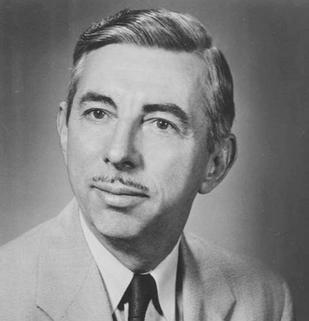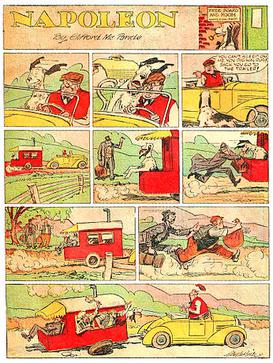Related Research Articles
United Feature Syndicate, Inc. (UFS) is a large American editorial column and comic strip newspaper syndication service based in the United States and established in 1919. Originally part of E. W. Scripps Company, it was part of United Media from 1978 to 2011, and is now a division of Andrews McMeel Syndication. United Features has syndicated many notable comic strips, including Peanuts, Garfield, Li'l Abner, Dilbert, Nancy, and Marmaduke.

The Newspaper Enterprise Association (NEA) is an editorial column and comic strip newspaper syndication service based in the United States and established in 1902. The oldest syndicate still in operation, the NEA was originally a secondary news service to the Scripps Howard News Service; it later evolved into a general syndicate best known for syndicating the comic strips Alley Oop, Our Boarding House, Freckles and His Friends, The Born Loser, Frank and Ernest, and Captain Easy / Wash Tubbs; in addition to an annual Christmas comic strip. Along with United Feature Syndicate, the NEA was part of United Media from 1978 to 2011, and is now a division of Andrews McMeel Syndication. The NEA once selected college All-America teams, and presented awards in professional football and professional [NBA] basketball.

Al Smith was an American cartoonist whose work included a long run on the comic strip Mutt and Jeff. Comics historian R. C. Harvey postulates that Smith's nearly 50-year run on the strip was, at the time of Smith's retirement, a world record for longevity. Smith also ran a comic strip syndication service — mainly serving weekly newspapers — from the 1950s until the late 1990s.
A comic strip syndicate functions as an agent for cartoonists and comic strip creators, placing the cartoons and strips in as many newspapers as possible on behalf of the artist. A syndicate can annually receive thousands of submissions, from which only two or three might be selected for representation. In some cases, the work will be owned by the syndicate as opposed to the creator. The Guinness World Record for the world's most syndicated strip belongs to Jim Davis' Garfield, which at that point (2002) appeared in 2,570 newspapers, with 263 million readers worldwide.

The Washington Post Writers Group (WPWG), a division of The Washington Post News Service & Syndicate, is a press syndication service distributing opinion columnists, breaking news, podcasts and video journalism, lifestyle content, and graphics and data visualizations. The service is operated by The Washington Post.
George Matthew Adams was an American newspaper columnist and founder of the George Matthew Adams Newspaper Service, which syndicated comic strips and columns to newspapers for five decades. His own writings were circulated widely to The Gettysburg Times and many other newspapers.

McClure Newspaper Syndicate, the first American newspaper syndicate, introduced many American and British writers to the masses. Launched in 1884 by publisher Samuel S. McClure, it was the first successful company of its kind. It turned the marketing of comic strips, columns, book serials and other editorial matter into a large industry, and a century later, 300 syndicates were distributing 10,000 features with combined sales of $100 million a year.

Napoleon and Uncle Elby was a popular syndicated newspaper comic strip created by Clifford McBride, which launched on June 6, 1932. Over a span of 29 years it was distributed to both American and foreign newspapers. By the mid-1940s, the strip was carried by 80 newspapers.
Bruce Lee has been portrayed in comics form in both comic books and syndicated newspaper strips.
The Bell Syndicate, launched in 1916 by editor-publisher John Neville Wheeler, was an American syndicate that distributed columns, fiction, feature articles and comic strips to newspapers for decades. It was located in New York City at 247 West 43rd Street and later at 229 West 43rd Street. It also reprinted comic strips in book form.
The Central Press Association was American newspaper syndication company based in Cleveland, Ohio. It was in business from 1910 to 1971. Originally independent, it was a subsidiary of King Features Syndicate from 1930 onwards. At its peak, the Central Press supplied features, columns, comic strips, and photographs to more than 400 newspapers and 12 million daily readers. Notable comic strips that originated with Central Press include Brick Bradford, Etta Kett, and Muggs McGinnis.
Chronicle Features was the syndication arm of the San Francisco Chronicle. Syndicating comic strips, newspaper columns, and editorial features, it operated from 1962 to c. 1998. The syndicate was known for the offbeat comic strips it championed, such as Gary Larson's The Far Side, Dan Piraro's Bizarro, and the editorial cartoons of Ted Rall. The service was acquired by Universal Press Syndicate in 1997 and went defunct soon after.
The Field Newspaper Syndicate was a syndication service based in Chicago that operated independently from 1941 to 1984, for a good time under the name the Chicago Sun-Times Syndicate. The service was founded by Marshall Field III and was part of Field Enterprises. The syndicate was most well known for Steve Canyon, but also launched such popular, long-running strips as The Berrys, From 9 To 5, Rivets, and Rick O'Shay. Other features included the editorial cartoons of Bill Mauldin and Jacob Burck, and the "Ask Ann Landers" advice column.
The Public Ledger Syndicate was a syndication company operated by the Philadelphia Public Ledger that was in business from 1915 to circa 1950. The Ledger Syndicate distributed comic strips, panels, and columns to the United States and the United Kingdom, Ireland, Canada, Sweden, New Zealand, and Australia. The syndicate also distributed material from the Curtis Publishing Company's other publications, including The Saturday Evening Post, Ladies' Home Journal, and The Country Gentleman.
Lafave Newspaper Features was a syndication service that operated from 1931 to 1963. It was founded by Cleveland businessman Arthur J. Lafave and specialized in comic strips and gag cartoons. It is most well known for syndicating Clifford McBride's Napoleon and Uncle Elby. The syndicate also distributed Louise Davis' column Today's Etiquette.
The New York Herald Tribune Syndicate was the syndication service of the New York Herald Tribune. Syndicating comic strips and newspaper columns, it operated from c. 1914 to 1966. The syndicate's most notable strips were Mr. and Mrs., Our Bill, Penny, Miss Peach, and B.C. Syndicated columns included Walter Lippmann's Today and Tomorrow, Weare Holbrook's Soundings, George Fielding Eliot's military affairs column, and John Crosby's radio and television column. Irita Bradford Van Doren was book review editor for a time.
General Features Corporation was a syndication service that operated from 1937 to 1974. It was founded by S. George Little and billed itself in the early 1950 as "America's Leading Independent Syndicate." By 1967, General Features distributed 80 columns, comic strips, and editorial features.
Columbia Features was a syndication service that operated from 1953 to 1994. Originally located in New York City, The syndicate specialized in comic strips based on licensed characters such as Smokey the Bear, Bat Masterson, and Nero Wolfe.
The New York World was one of the first newspapers to publish comic strips, starting around 1890, and contributed greatly to the development of the American comic strip. Notable strips that originated with the World included Richard F. Outcault's Hogan's Alley, Rudolph Dirks' The Captain and the Kids, Denys Wortman's Everyday Movies, Fritzi Ritz, Gus Mager's Hawkshaw the Detective, Victor Forsythe's Joe Jinks, and Robert Moore Brinkerhoff's Little Mary Mixup.
References
- 1 2 "LATS to Release Bruce Lee Strip," The Comics Journal #73 (July 1982), p. 13.
- 1 2 "Times Mirror Company And General Features," New York Times (January 4, 1967), p. 84.
- ↑ Katina Alexander (June 14, 1987). "A Superhero For Cartoonists?". New York Times . p. 34. Retrieved August 18, 2012.
- ↑ Barringer, Felicity; Holson, Laura M. (2000-03-14). "MULTIMEDIA DEAL: THE DEAL; Tribune Company Agrees to Buy Times Mirror". The New York Times. ISSN 0362-4331 . Retrieved 2016-02-21.
- ↑ Astor, Dave (2002). "Tms to Shut Two Offices". Editor & Publisher. 135: 10.
- 1 2 "Bill Ziegler," Who's Who of American Comic Books: 1928–1999. Accessed Nov. 30, 2017.
- ↑ "Mel Keefer," Who's Who of American Comic Books: 1928–1999. Accessed Nov. 30, 2017.
- ↑ "Dan Spiegle," Who's Who of American Comic Books: 1928–1999. Accessed Nov. 30, 2017.
- ↑ "Eisenhower Story Strip From Mirror Syndicate," Editor & Publisher (May 10, 1952). Archived at Stripper's Guide.
- 1 2 "Stan Lee," Who's Who of American Comic Books: 1928–1999. Accessed Nov. 30, 2017.
- ↑ "'Irma', Radio-Movie Star, Goes Newspaper," Editor & Publisher (July 29, 1950). Archived at Stripper's Guide.
- ↑ "Dan De Carlo 1," Who's Who of American Comic Books: 1928–1999. Accessed Nov. 30, 2017.
- ↑ Wells, John; Dallas, Keith (February 26, 2013). American Comic Book Chronicles: 1960-64. TwoMorrows Publishing. p. 9. ISBN 978-1-60549-045-8.
- 1 2 Knoll, Erwin. "Napoleon" Strip Moves To Mirror Syndicate," Editor & Publisher (September 20, 1952). Archived at Stripper's Guide. Accessed Oct. 31, 2018.
- ↑ "Roger Armstrong," Who's Who of American Comic Books: 1928–1999. Accessed Nov. 30, 2017.
- ↑ "Joe Messerli," Who's Who of American Comic Books: 1928–1999. Accessed Nov. 30, 2017.
- ↑ "Kay Wright," Who's Who of American Comic Books: 1928–1999. Accessed Nov. 30, 2017.
- ↑ Holtz, Allan. "Obscruity of the Day: Soapy Waters," Stripper's Guide (January 10, 2007).
- ↑ Holtz, Allan. "Obscurity of the Day: Times Have Changed," Stripper's Guide (Dec. 3, 2008).
- ↑ "Ed Nofziger," Who's Who of American Comic Books: 1928–1999. Accessed Nov. 30, 2017.
- ↑ "Jim Lawrence," Who's Who of American Comic Books: 1928–1999. Accessed Nov. 30, 2017.
- ↑ "Paul Chadwick," Who's Who of American Comic Books: 1928–1999. Accessed Nov. 30, 2017.
- ↑ "Ron Harris," Who's Who of American Comic Books: 1928–1999. Accessed Nov. 30, 2017.
- ↑ "Deryl Skelton," Who's Who of American Comic Books: 1928–1999. Accessed Nov. 30, 2017.
- ↑ "Pete Hoffman," Who's Who of American Comic Books: 1928–1999. Accessed Nov. 30, 2017.
- ↑ Jeff Cobb at Don Markstein's Toonopedia. Archived from the original on October 8, 2016.
- ↑ "Sharman Di Vono," Who's Who of American Comic Books: 1928–1999. Accessed Nov. 30, 2017.
- ↑ "Fran Matera," Who's Who of American Comic Books: 1928–1999. Accessed Nov. 30, 2017.
- ↑ Degg, D. D. (June 1, 2022). "Loose Parts Changes Syndicates (Again)". The Daily Cartoonist.
- ↑ Horn, Maurice, ed. (1996). 100 Years of American Newspaper Comics. New York York: Gramercy Books. pp. 190–191. ISBN 0-517-12447-5.
- ↑ "'Coloring Outside the Lines: Black Cartoonists as Social Commentators' exhibit to open at Laney". Oakland Local. August 6, 2010. Archived from the original on August 23, 2010. Retrieved February 23, 2014.
- ↑ Foran, Chris. "GREEN SHEET|THROWBACK THURSDAY: COMICS EDITION: 'Mr. Tweedy,' the Green Sheet's long-running lovable loser," Milwaukee Journal-Sentinel (March 23, 2016).
- ↑ "Enric Badia Romero," Who's Who of American Comic Books: 1928–1999. Accessed Nov. 30, 2017.
- ↑ "Lee Nordling," Who's Who of American Comic Books: 1928–1999. Accessed Nov. 30, 2017.
- ↑ "Los Angeles Times Syndicate Star Trek newspaper comic strip" . Retrieved 2006-12-25.
- ↑ "I Love Comix Archive: Los Angeles Times Syndicate Star Trek newspaper comic strip" . Retrieved 2010-04-30.
- ↑ "John Buscema," Who's Who of American Comic Books: 1928–1999. Accessed Nov. 30, 2017.
- ↑ "Frank Springer," Who's Who of American Comic Books: 1928–1999. Accessed Nov. 30, 2017.
- ↑ "Neal Sternecky," Who's Who of American Comic Books: 1928–1999. Accessed Nov. 30, 2017.